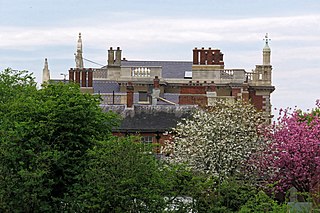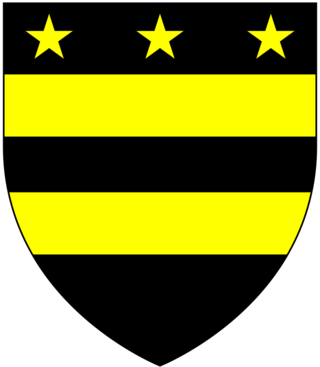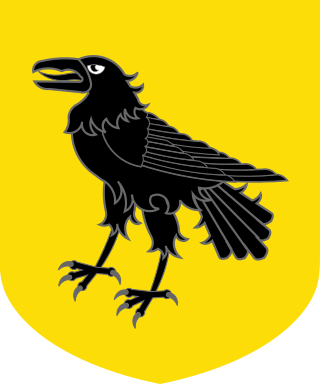Related Research Articles

Earl of Limerick is a title that has been created twice in the Peerage of Ireland, associated first with the Dongan family, then with the Pery family. It should not be confused with the title Viscount of the City of Limerick held by the Hamilton family also Earls of Clanbrassil.

Baron Farnham, of Farnham in the County of Cavan, is a title in the Peerage of Ireland. It was created in 1756 for John Maxwell, who had previously represented Cavan Borough in the Irish House of Commons. John Maxwell's son, the second Baron, was created Viscount Farnham in 1760 and Earl of Farnham in 1763. Both titles were in the Peerage of Ireland but became extinct when he died childless in 1779. His brother and successor, the third Baron, was again created Viscount Farnham in 1781 and Earl of Farnham in 1785. These titles were also in the Peerage of Ireland. His son, the second Earl, sat in the House of Lords as an Irish Representative Peer from 1816 to 1823. However, he had no children and on his death in 1823 the viscountcy and earldom became extinct.

Charles Palmer, later Charles FitzRoy, 2nd Duke of Cleveland, 1st Duke of Southampton, KG, Chief Butler of England, styled Baron Limerick before 1670 and Earl of Southampton between 1670 and 1675 and known as The Duke of Southampton from 1675 until 1709 when he succeeded his mother to the dukedom of Cleveland.

Viscount Grandison, of Limerick, is a title in the Peerage of Ireland. It was created in 1620 for Sir Oliver St John, the Lord Deputy of Ireland. He was the descendant and namesake of Oliver St John, whose elder brother Sir John St John was the ancestor of the Barons St John of Bletso and the Earls of Bolingbroke. Moreover, St John's nephew Sir John St John, 1st Baronet, of Lydiard Tregoze, was the ancestor of the Viscounts Bolingbroke and the Viscounts St John.
Nineteen baronetcies have been created for persons with the surname Hamilton, eight in the Baronetage of Nova Scotia, one in the Baronetage of England, five in the Baronetage of Ireland, one in the Baronetage of Great Britain and four in the Baronetage of the United Kingdom. As of 2008 two creations are extant, two are dormant, two are either extinct or dormant and twelve extinct.
There have been three baronetcies created for members of the Stonhouse family, all in the Baronetage of England. Two of the creations are extant as of 2021.
There have been four baronetcies for persons with the surname Blake, one in the Baronetage of Ireland, two in the Baronetage of Great Britain and one in the Baronetage of the United Kingdom. Two of the creations are extant as of 2010. The Blake Baronetcy, of Menlough in the County of Galway, was created in the Baronetage of Ireland on 10 July 1622 for Valentine Blake, Mayor of Galway in 1611 and 1630 and a member of the Irish House of Commons for County Galway. His grandfather Thomas Blake had preceded him as Mayor. The second Baronet was a member of the Irish Parliament for Galway Borough. The third Baronet represented both County Galway and Galway Borough in Parliament. The sixth Baronet was a member of the Irish House of Commons for County Galway. He was the first Catholic gentlemen of distinction to join William of Orange. The twelfth Baronet represented Galway Borough in the British House of Commons. The fourteenth Baronet was high sheriff of County Galway in 1872. See also the Blake Baronetcy of Twizell Castle below.

There have been two baronetcies created for people with the surname Barrington. As of 2014 one creation is extant.
There have been four baronetcies created for persons with the surname FitzGerald, one in the Baronetage of Ireland and three in the Baronetage of the United Kingdom.

There have been two baronetcies created for persons with the surname Freke, one in the Baronetage of Great Britain and one in the Baronetage of Ireland.
The Fenton Baronetcy, of Mitchelstown in the County of Cork, was a title in the Baronetage of Ireland. It was created on 22 July 1661 for Maurice Fenton. The baronetcy became extinct on 17 March 1670, with the death of his son William Fenton.
The Fitzharris Baronetcy, of Kilfinin in the County of Limerick, was a title in the Baronetage of Ireland. It was created on 4 November 1622 for Edward Fitzharris. His son, the second Sir Edward, was described as an eminent Royalist during the English Civil War. The title became extinct on the death of the third Baronet around 1704. The notorious Popish Plot informer Edward Fitzharris, executed for treason in 1681, was a younger son of the second Baronet. He had several children, but his male issue must have been dead by 1704 when the title became extinct.
The Hartstonge Baronetcy, of Bruff in the County of Limerick, was a title in the Baronetage of Ireland. It was created on 20 April 1681 for Standish Hartstonge, an English-born judge who sat on the Irish Court of Exchequer, and who had inherited estates at Bruff from his mother's family, the Standishes. The second Baronet, his grandson, was a member of the Irish House of Commons for Kilmallock, Ratoath and St Canice. The third Baronet was a member of the Irish Parliament for County Limerick. The title became extinct on his death in 1797, when the Hartstonge estates passed by inheritance to the Earl of Limerick.
The High Sheriff of Limerick was the British Crown's judicial representative in County Limerick, Ireland from the 13th century until 1922, when the office was abolished in the new Free State and replaced by the office of Limerick County Sheriff. The sheriff had judicial, electoral, ceremonial and administrative functions and executed High Court Writs. In 1908, an Order in Council made the Lord-Lieutenant the Sovereign's prime representative in a county and reduced the High Sheriff's precedence. However, the sheriff retained his responsibilities for the preservation of law and order in the county. The usual procedure for appointing the sheriff from 1660 onwards was that three persons were nominated at the beginning of each year from the county and the Lord Lieutenant then appointed his choice as High Sheriff for the remainder of the year. Often the other nominees were appointed as under-sheriffs. Sometimes a sheriff did not fulfil his entire term through death or other event and another sheriff was then appointed for the remainder of the year. The dates given hereunder are the dates of appointment. All addresses are in County Limerick unless stated otherwise.
The Dean of Lismore is based at The Cathedral Church of St Carthage, Lismore in the united Diocese of Cashel and Ossory within the Church of Ireland.
The Hunt, later de Vere Baronetcy, of Curragh in the County of Limerick, was a title in the Baronetage of Ireland. It was created on 4 December 1784 for Vere Hunt, who subsequently represented Askeaton in the Irish House of Commons. The second Baronet assumed the surname of de Vere in lieu of his patronymic in 1832. The fourth Baronet represented County Limerick in Parliament. The title became extinct on his death in 1904.
There have been five baronetcies created for persons with the surname Tyrrell, all in the Baronetage of England. All five creations are extinct, as is the Tyrell baronetcy. The six creations all claim a descent from Walter Tirell, the reputed accidental killer of King William II.
The Governor of Limerick was a military officer who commanded the garrison at Limerick in Ireland.
Sir John Fitzgerald, 2nd Baronet was an Irish Jacobite politician and soldier.

The Corbet baronetcy, of Stoke upon Tern in the County of Shropshire, was created in the Baronetage of England on 19 September 1627 for John Corbet.
References
- Leigh Rayment's list of baronets
- National Library of Ireland- the Limerick Papers